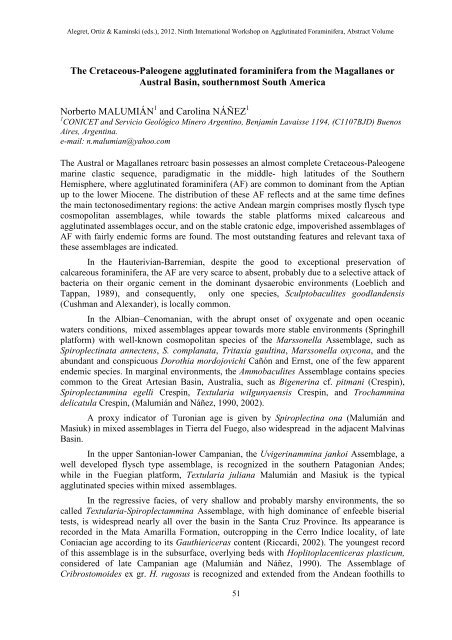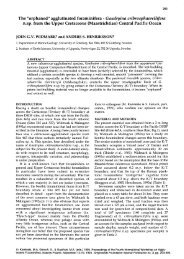Full Text | Download - Grzybowski Foundation - The ...
Full Text | Download - Grzybowski Foundation - The ...
Full Text | Download - Grzybowski Foundation - The ...
You also want an ePaper? Increase the reach of your titles
YUMPU automatically turns print PDFs into web optimized ePapers that Google loves.
Alegret, Ortiz & Kaminski (eds.), 2012. Ninth International Workshop on Agglutinated Foraminifera, Abstract Volume<br />
<strong>The</strong> Cretaceous-Paleogene agglutinated foraminifera from the Magallanes or<br />
Austral Basin, southernmost South America<br />
Norberto MALUMIÁN 1 and Carolina NÁÑEZ 1<br />
1 CONICET and Servicio Geológico Minero Argentino, Benjamín Lavaisse 1194, (C1107BJD) Buenos<br />
Aires, Argentina.<br />
e-mail: n.malumian@yahoo.com<br />
<strong>The</strong> Austral or Magallanes retroarc basin possesses an almost complete Cretaceous-Paleogene<br />
marine clastic sequence, paradigmatic in the middle- high latitudes of the Southern<br />
Hemisphere, where agglutinated foraminifera (AF) are common to dominant from the Aptian<br />
up to the lower Miocene. <strong>The</strong> distribution of these AF reflects and at the same time defines<br />
the main tectonosedimentary regions: the active Andean margin comprises mostly flysch type<br />
cosmopolitan assemblages, while towards the stable platforms mixed calcareous and<br />
agglutinated assemblages occur, and on the stable cratonic edge, impoverished assemblages of<br />
AF with fairly endemic forms are found. <strong>The</strong> most outstanding features and relevant taxa of<br />
these assemblages are indicated.<br />
In the Hauterivian-Barremian, despite the good to exceptional preservation of<br />
calcareous foraminifera, the AF are very scarce to absent, probably due to a selective attack of<br />
bacteria on their organic cement in the dominant dysaerobic environments (Loeblich and<br />
Tappan, 1989), and consequently, only one species, Sculptobaculites goodlandensis<br />
(Cushman and Alexander), is locally common.<br />
In the Albian–Cenomanian, with the abrupt onset of oxygenate and open oceanic<br />
waters conditions, mixed assemblages appear towards more stable environments (Springhill<br />
platform) with well-known cosmopolitan species of the Marssonella Assemblage, such as<br />
Spiroplectinata annectens, S. complanata, Tritaxia gaultina, Marssonella oxycona, and the<br />
abundant and conspicuous Dorothia mordojovichi Cañón and Ernst, one of the few apparent<br />
endemic species. In marginal environments, the Ammobaculites Assemblage contains species<br />
common to the Great Artesian Basin, Australia, such as Bigenerina cf. pitmani (Crespin),<br />
Spiroplectammina egelli Crespin, <strong>Text</strong>ularia wilgunyaensis Crespin, and Trochammina<br />
delicatula Crespin, (Malumián and Náñez, 1990, 2002).<br />
A proxy indicator of Turonian age is given by Spiroplectina ona (Malumián and<br />
Masiuk) in mixed assemblages in Tierra del Fuego, also widespread in the adjacent Malvinas<br />
Basin.<br />
In the upper Santonian-lower Campanian, the Uvigerinammina jankoi Assemblage, a<br />
well developed flysch type assemblage, is recognized in the southern Patagonian Andes;<br />
while in the Fuegian platform, <strong>Text</strong>ularia juliana Malumián and Masiuk is the typical<br />
agglutinated species within mixed assemblages.<br />
In the regressive facies, of very shallow and probably marshy environments, the so<br />
called <strong>Text</strong>ularia-Spiroplectammina Assemblage, with high dominance of enfeeble biserial<br />
tests, is widespread nearly all over the basin in the Santa Cruz Province. Its appearance is<br />
recorded in the Mata Amarilla Formation, outcropping in the Cerro Indice locality, of late<br />
Coniacian age according to its Gauthiericeras content (Riccardi, 2002). <strong>The</strong> youngest record<br />
of this assemblage is in the subsurface, overlying beds with Hoplitoplacenticeras plasticum,<br />
considered of late Campanian age (Malumián and Náñez, 1990). <strong>The</strong> Assemblage of<br />
Cribrostomoides ex gr. H. rugosus is recognized and extended from the Andean foothills to<br />
51



